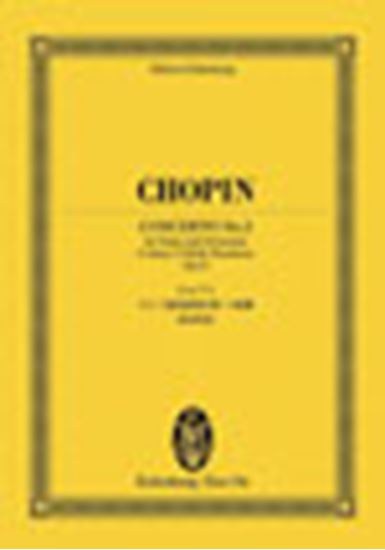Chopin, Frederic : Concerto pour piano et orchestre no.2 f-moll Op.21
Work Overview
Publication Year:1836
First Publisher:Leipzig, Paris and London
Dedicated to:Comtesse Delphine Potocka née de Komar
Instrumentation:Concerto
Genre:concerto
Total Playing Time:32 min 00 sec
Copyright:Public Domain
Commentary (1)
Author : Okada, Akihiro
Last Updated: March 1, 2010
[Open]
Author : Okada, Akihiro
Chopin's first piano concerto (No. 2) was commenced in 1829 and completed the following year. Chopin had already composed works showcasing his piano virtuosity with orchestral accompaniment, such as Variations on "Là ci darem la mano" and Krakowiak, achieving success not only in Warsaw but also in Vienna. However, he felt that a three-movement "concerto" was necessary for his further success. This was greatly influenced by the overwhelming success achieved by virtuosos of the time, such as Hummel and Field, with their piano concertos in classical forms, and Chopin's piano concertos are naturally positioned as an extension of their compositional style.
The often-noted weakness of the orchestral parts is due to the fundamental difference between Chopin's piano concertos and those of symphonic composers like Schumann and Brahms, making discussion of this point futile. Furthermore, as Jan Ekier has pointed out, there is no definitive evidence that the composer himself orchestrated the work, and it is highly probable that it was done by someone else. On the other hand, the structural weakness of the work has also been frequently noted. In recent years, there has been a tendency to positively interpret these weaknesses as the originality of a young genius, but this misunderstands the true nature of the work.
For example, as described below, the tonal structure of the first movement of this concerto contradicts the fundamental principles of sonata form. Prior to this concerto, Chopin composed pieces with sonata form, such as the Piano Sonata in C minor and the Piano Trio, as studies, but in all of them, the key settings disregard the norms of classical sonata form.
This is not unrelated to the weakness of the tonal structure in the F minor Concerto and the subsequent E minor Concerto, reflecting that Chopin at the time had not yet fully assimilated classical forms and harmony. Therefore, to easily interpret these points positively as "originality" would distort the image of the young Chopin. In other words, the virtues of Chopin during his Warsaw period were, first and foremost, bel canto-like melodic beauty, and brilliant virtuoso passages, with the musical structure being secondary.
Such an understanding does not diminish Chopin as a composer but is an important point that performers must recognize.
First Movement: F minor, 4/4 time
Although often described as a concerto-style sonata form, if sonata form is understood as a tonal framework that resolves tonal conflict in the first half during the second half, then this movement is a three-part or two-part form with the exposition of two themes and their recapitulation.
First, the orchestra alone presents two themes in F minor and A-flat major, followed by the solo piano repeating both themes with added ornamentation. This compositional method is indeed typical of a concerto-style sonata form. The transition section is then expanded, becoming a showcase for the solo piano's virtuosic passages.
The development-like second part (m. 205–) is a transitional section primarily based on the motif of the F minor theme. As the orchestra repeats this motif in a sequential manner, the solo piano develops improvisatory passages. Once the orchestral tutti builds to the climax of the movement, it quickly subsides, and the opening theme is recapitulated by the piano (m. 268–). If this movement is considered a three-part form, then this marks the beginning of the third part.
Following the F minor theme, the A-flat major theme appears immediately without a change of key. This leads to a transition section with virtuosic passages, and the movement concludes with a coda where the opening theme returns.
Second Movement: A-flat major, 4/4 time
A lyrical movement that was composed prior to the first and third movements. According to the composer's own statements, he composed it with Konstancja, whom he then called his "ideal person," in mind.
Following a short introduction by the string ensemble, a nocturne-like theme is sung by the solo piano.
Throughout the movement, the solo piano sings the melody, employing various ornaments. Finally, the theme from the introduction returns, bringing the movement to a close.
Third Movement: F minor, 3/4 time
Although often described as a rondo, it should be viewed as an expanded two-part dance form.
A Kujawiak-like theme is presented by the solo piano. Following an orchestral episode, a chain of virtuosic passages by the solo piano begins, and musical ideas unfold one after another to the rhythm of a mazurka.
In particular, the unison musical idea (m. 145–) characterized by eighth-note triplets and dotted rhythms contributes to further enhancing the folk-music atmosphere of the entire movement.
The opening theme returns, marking the second half (m. 325–), but the end of the orchestral episode is transformed, shifting to F major (the parallel major). After virtuosic piano passages, the mazurka-like musical idea returns, bringing the piece to a close.
Movements (3)
Arrangements & Related Works(1) <Show>
PTNA & Partner Channel Videos(19items) View More
- favorite_border
- 0
Recording Date: 2020/8/21
Recording Location: サントリーホール 大ホール(2020年ピティナ・ピアノコンペティション 特級 ファイナル)
- favorite_border
- 0
Recording Date: 2020/8/21
Recording Location: サントリーホール 大ホール(2020年ピティナ・ピアノコンペティション 特級 ファイナル)
- favorite_border
- 0
Recording Date: 2020/8/21
Recording Location: サントリーホール 大ホール(2020年ピティナ・ピアノコンペティション 特級 ファイナル)
- favorite_border
- 1
Recording Date: 2011/8/21
Recording Location: 第一生命ホール(2011年ピティナ・ピアノコンペティション 特級 ファイナル)
- favorite_border
- 0
Recording Date: 2011/8/21
Recording Location: 第一生命ホール(2011年ピティナ・ピアノコンペティション 特級 ファイナル)
- favorite_border
- 0
Recording Date: 2011/8/21
Recording Location: 第一生命ホール(2011年ピティナ・ピアノコンペティション 特級 ファイナル)
- favorite_border
- 0
Recording Date: 2012/8/21
Recording Location: 第一生命ホール(2012年ピティナ・ピアノコンペティション 特級 ファイナル)
Reference Videos & Audition Selections(4items)
Sheet Music
Scores List (8)

(株)全音楽譜出版社

(株)リットーミュージック

(株)全音楽譜出版社(ポケットスコア)

(株)シンコーミュージックエンタテイメント

ハンナ(ショパン)

(株)ヤマハミュージックエンタテインメントホールディングス

(株)シンコーミュージックエンタテイメント















